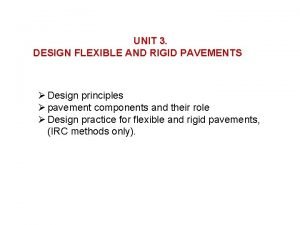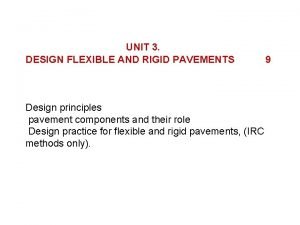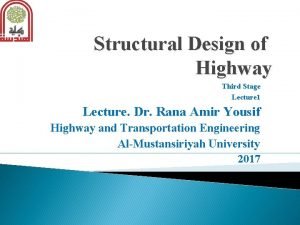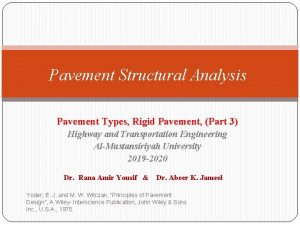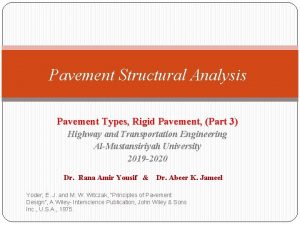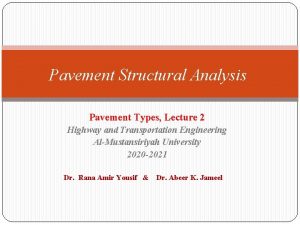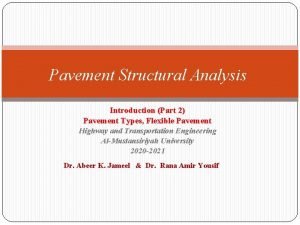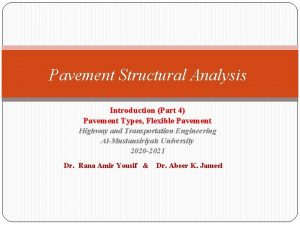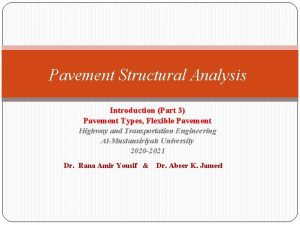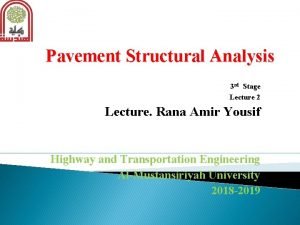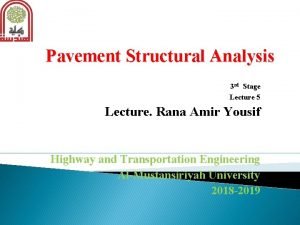Pavement Structural Analysis 3 rd Stage Lecture 1










- Slides: 10

Pavement Structural Analysis 3 rd Stage Lecture 1 Lecture. Rana Amir Yousif Highway and Transportation Engineering Al-Mustansiriyah University 2018 -2019

References: � Nicholas J. Garber and Lester A. Hoel. ”Traffic and Highway Engineering”, Fourth Edition. � Yoder; E. J. and M. W. Witczak, “Principles of Pavement Design”, A Wiley- Interscience Publication, John Wiley & Sons Inc. , U. S. A. , 1975. � Yaug H. Huang, “Pavement Analysis and Design”, Prentic Hall Inc. , U. S. A. , 1993. � “AASHTO Guide for Design of Pavement Structures 1993”, AASHTO, American Association of State Highway and Transportation Officials, U. S. A. , 1993. � Oglesby Clarkson H. , “Highway Engineering”, John Wiley & Sons Inc. , U. S. A. , 1975.

PAVEMENT TYPES There are three major types of pavements: flexible or asphalt pavements, rigid or concrete pavements, and composite pavements. 1. 1 Flexible Pavements: Flexible pavement can be defined as the one consisting of a mixture of asphaltic or bituminous material and aggregates placed on a bed of compacted granular material of appropriate quality in layers over the subgrade. Water bound macadam roads and stabilized soil roads with or without asphaltic toppings are examples of flexible pavements. The design of flexible pavement is based on the principle that for a load of any magnitude, the intensity of a load diminishes as the load is transmitted downwards from the surface by virtue of spreading over an increasingly larger area, by carrying it deep enough into the ground through successive layers of granular material.


Thus for flexible pavement, there can be grading in the quality of materials used, the materials with high degree of strength is used at or near the surface. Thus the strength of subgrade primarily influences the thickness of the flexible pavement.

Types of Flexible Pavements The following types of construction have been used in flexible pavement: � Conventional layered flexible pavement, � Full - depth asphalt pavement, and � Contained rock asphalt mat (CRAM). Conventional flexible pavements are layered systems with high quality expensive materials are placed in the top where stresses are high, and low quality cheap materials are placed in lower layers. Figure 1. 2 shows the cross section of a conventional flexible pavement. Starting from the top, the pavement consists of seal coat, surface course, tack coat, binder course, prime coat, base course, subbase course, compacted subgrade, and natural subgrade. The use of the various courses is based on either necessity or economy, and some of the courses may be omitted.

Figure 1. 2: Typical cross section of a conventional flexible pavement (1 in. = 25. 4 mm).

Full - depth asphalt pavements : Full-depth asphalt pavements are constructed by placing one or more layers of HMA directly on the subgrade or improved subgrade. This concept was conceived by the Asphalt Institute in 1960 and is generally considered the most cost-effective and dependable type of asphalt pavement for heavy traffic. This type of construction is quite popular in areas where local materials are not available. It is more convenient to purchase only one material, i. e. , HMA, rather than several materials from different sources, thus minimizing the administration and equipment costs. Figure 1. 3 shows the typical cross section for a full-depth asphalt pavement. The asphalt base course in the full-depth construction is the same as the binder course in conventional pavement. As with conventional pavement, a tack coat must be applied between two asphalt layers to bind them together.

Figure 1. 3: Typical cross-section of a full-depth asphalt pavement (1 in. = 25. 4 mm).

According to the Asphalt Institute (AI, 1987), full-depth asphalt pavements have the following advantages: 1. They have no permeable granular layers to entrap water and impair performance. 2. Time required for construction is reduced. On widening projects, where adjacent traffic flow must usually be maintained, full-depth asphalt can be especially advantageous. 3. When placed in a thick lift of 4 in. (102 mm) or more, construction seasons may be extended. 4. They provide and retain uniformity in the pavement structure. 5. They are less affected by moisture or frost. 6. According to limited studies, moisture contents do not build up in subgrades under full-depth asphalt pavement structures as they do under pavements with granular bases. Thus, there is little or no reduction in subgrade strength.
